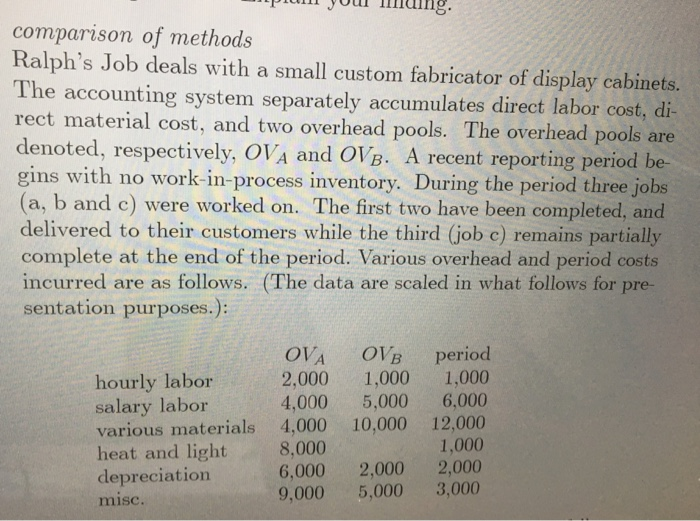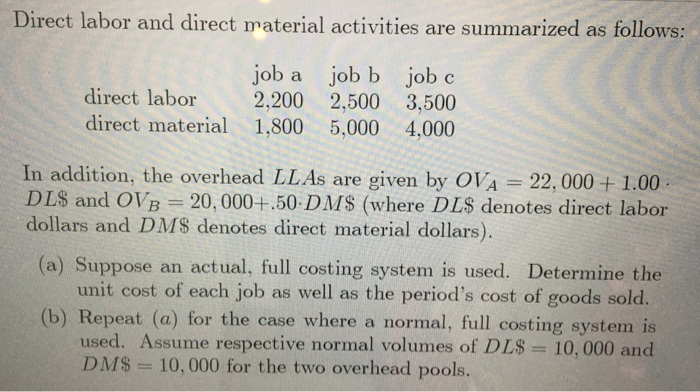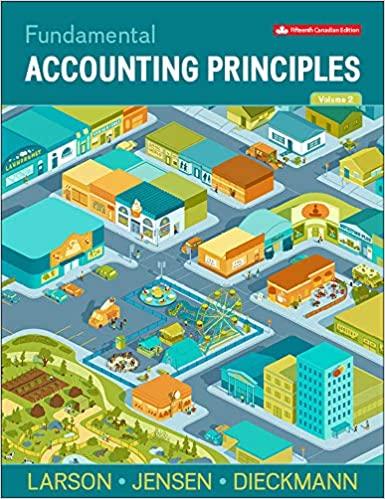Answered step by step
Verified Expert Solution
Question
1 Approved Answer
c) repeat a) for the case where normal , variable costing is used. Please provide a full answer wirh explanations and interpretations. Ralphs Job deals


c) repeat a) for the case where normal , variable costing is used.
Please provide a full answer wirh explanations and interpretations.
Ralphs Job deals with a small custom fabricator of display cabinets.
The accounting system separately accumulates direct labor cost, direct
material cost, and two overhead pools. The overhead pools are
denoted, respectively, OVA and OVB. A recent reporting period begins
with no work-in-process inventory. During the period three jobs
(a, b and c) were worked on. The first two have been completed, and
delivered to their customers while the third (job c) remains partially
complete at the end of the period. Various overhead and period costs
incurred are as follows. (The data are scaled in what follows for presentation
purposes.):

In addition, the overhead LLAs are given by OVA = 22, 000 + 1.00 DL$ and OVB = 20, 000+.50DM$ (where DL$ denotes direct labor
dollars and DM$ denotes direct material dollars).
(a) Suppose an actual, full costing system is used. Determine the
unit cost of each job as well as the periods cost of goods sold.
(b) Repeat (a) for the case where a normal, full costing system is
us
ed. Assume respective normal volumes of DL$ = 10, 000 and
DM$ = 10, 000 for the two overhead pools.
(c) Repeat (a) for the case where normal, variable costing is used.
The picture might not be clear, but underneath it its the same question writen down for clarifications. These are the information given, taken exactly from the book . please offer a solution with interpretation of the results. Thank you !
comparison of methods Ralph's Job deals with a small custom fabricator of display cabinets. The accounting system separately accumulates direct labor cost, di- rect material cost, and two overhead pools. The overhead pools are denoted, respectively, OVA and OVB. A recent reporting period be- gins with no work-in-process inventory. During the period three jobs (a, b and c) were worked on. The first two have been completed, and delivered to their customers while the third (job c) remains partially complete at the end of the period. Various overhead and period costs incurred are as follows. (The data are scaled in what follows for pre- sentation purposes.): OVB 1,000 period 1,000 6,000 OVA 2,000 4,000 4,000 8,000 6,000 9,000 hourly labor salary labor various materials heat and light depreciation misc. 5,000 10,000 12,000 1,000 2,000 3,000 2,000 5,000 Direct labor and direct material activities are summarized as follows: job a job b job c 2,200 2,500 3,500 direct labor direct material 1,800 5,000 4,000 In addition, the overhead LLAS are given by OVA = 22, 000 + 1.00 DL$ and OVB= 20, 000+.50 DM$ (where DL$ denotes direct labor dollars and DM$ denotes direct material dollars). (a) Suppose an actual, full costing system is used. Determine the unit cost of each job as well as the period's cost of goods sold. (b) Repeat (a) for the case where a normal, full costing system is used. Assume respective normal volumes of DL$ = 10,000 and DM$ = 10,000 for the two overhead pools. OVB period 1,000 OVA hourly labor salary labor 1,000 5,000 2,000 4,000 6,000 various materials 4,000 10,000 12,000 heat and light depreciation misc. 8,000 1,000 6,000 9,000 2,000 2,000 5,000 3,000 Direct labor and direct material activities are summarized as follows: job a job b job c 2,200 2,500 3,500 direct labor direct material 1,800 5,000 4,000 comparison of methods Ralph's Job deals with a small custom fabricator of display cabinets. The accounting system separately accumulates direct labor cost, di- rect material cost, and two overhead pools. The overhead pools are denoted, respectively, OVA and OVB. A recent reporting period be- gins with no work-in-process inventory. During the period three jobs (a, b and c) were worked on. The first two have been completed, and delivered to their customers while the third (job c) remains partially complete at the end of the period. Various overhead and period costs incurred are as follows. (The data are scaled in what follows for pre- sentation purposes.): OVB 1,000 period 1,000 6,000 OVA 2,000 4,000 4,000 8,000 6,000 9,000 hourly labor salary labor various materials heat and light depreciation misc. 5,000 10,000 12,000 1,000 2,000 3,000 2,000 5,000 Direct labor and direct material activities are summarized as follows: job a job b job c 2,200 2,500 3,500 direct labor direct material 1,800 5,000 4,000 In addition, the overhead LLAS are given by OVA = 22, 000 + 1.00 DL$ and OVB= 20, 000+.50 DM$ (where DL$ denotes direct labor dollars and DM$ denotes direct material dollars). (a) Suppose an actual, full costing system is used. Determine the unit cost of each job as well as the period's cost of goods sold. (b) Repeat (a) for the case where a normal, full costing system is used. Assume respective normal volumes of DL$ = 10,000 and DM$ = 10,000 for the two overhead pools. OVB period 1,000 OVA hourly labor salary labor 1,000 5,000 2,000 4,000 6,000 various materials 4,000 10,000 12,000 heat and light depreciation misc. 8,000 1,000 6,000 9,000 2,000 2,000 5,000 3,000 Direct labor and direct material activities are summarized as follows: job a job b job c 2,200 2,500 3,500 direct labor direct material 1,800 5,000 4,000 Step by Step Solution
There are 3 Steps involved in it
Step: 1

Get Instant Access to Expert-Tailored Solutions
See step-by-step solutions with expert insights and AI powered tools for academic success
Step: 2

Step: 3

Ace Your Homework with AI
Get the answers you need in no time with our AI-driven, step-by-step assistance
Get Started


